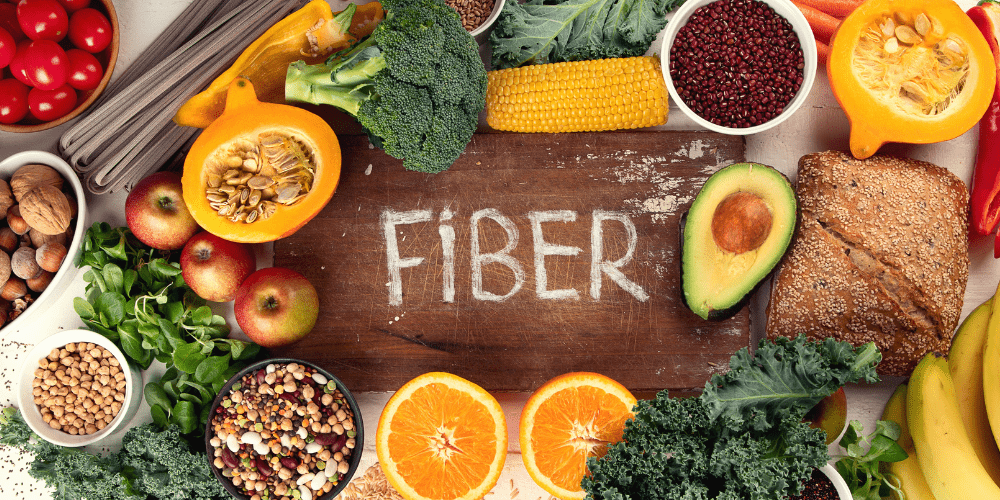As women age, their bodies undergo various changes that require special attention to nutrition and health. One of the key dietary components that become increasingly important for women over 45 is fiber. Fiber plays a crucial role in maintaining overall health and preventing a range of health issues that become more common with age. In this blog post, I’m going to discuss the significance of fiber for women over 45, exploring what fiber is, why it’s often lacking in women’s diets, the role of fiber in women’s health, and why women over 45 need more fiber than their younger women. I’ll also leave you with a helpful list of high-fiber foods and discuss strategies for incorporating more fiber into daily diets.
What is Fiber?
Fiber, also known as dietary fiber or roughage, is a type of carbohydrate that the body can’t digest or absorb. It’s found in plant-based foods such as fruits, vegetables, whole grains, legumes, and nuts. Fiber comes in two forms: soluble and insoluble. Soluble fiber dissolves in water and forms a gel-like substance in the digestive tract, which can help lower cholesterol levels and stabilize blood sugar. Insoluble fiber, on the other hand, doesn’t dissolve in water and adds bulk to stool, aiding in digestion and preventing constipation.
Why Don’t Women Eat Enough Fiber?
Despite the well-established benefits of fiber, many women, regardless of age, often fall short of consuming the recommended daily amount. Several factors contribute to this dietary shortfall:
- Busy Lifestyles: Juggling work, family, and other responsibilities can lead to opting for convenient, processed foods that are typically low in fiber.
- Misconceptions: Some women may mistakenly believe that they only need to focus on protein and calcium intake, overlooking the importance of fiber.
- Taste Preferences: High-fiber foods are not always the most appealing due to their texture or taste, leading to avoidance.
- Lack of Awareness: Many women may not be aware of the health benefits associated with a high-fiber diet or the specific dietary sources of fiber.
The Role of Fiber in Women’s Health
Fiber offers a myriad of health benefits, especially for women over 45:
- Digestive Health: Insoluble fiber adds bulk to stool and prevents constipation, promoting regular bowel movements and reducing the risk of digestive issues.
- Heart Health: Soluble fiber binds to cholesterol and removes it from the body, thereby reducing LDL (“bad”) cholesterol levels and lowering the risk of heart disease.
- Blood Sugar Regulation: Soluble fiber slows the absorption of sugar, preventing rapid spikes in blood sugar levels and helping manage conditions like diabetes.
- Weight Management: High-fiber foods are often low in calories and more filling, promoting satiety and reducing overeating.
- Hormonal Balance: Fiber aids in eliminating excess estrogen from the body, which is particularly important during perimenopause and menopause.
Why Do Women Over 45 Need More Fiber Than Younger Women?
As women age, hormonal changes, reduced metabolism, and a higher risk of chronic conditions necessitate an increased focus on dietary fiber:
- Digestive Function: Aging can lead to slower digestion, making it crucial to maintain regular bowel movements through a fiber-rich diet.
- Bone Health: Some high-fiber foods, such as legumes and nuts, also provide essential nutrients like magnesium, which supports bone health, a concern for women over 45.
- Heart Disease Prevention: The risk of heart disease rises with age. Fiber’s ability to lower cholesterol becomes even more valuable during this period.
- Weight Control: Metabolism tends to slow down with age, making weight management more challenging. Fiber-rich foods help control calorie intake and support weight loss efforts.
- Hormonal Changes: The fiber-related elimination of excess estrogen is vital during menopause to alleviate symptoms and reduce the risk of certain cancers.
Best Sources of Fiber
To help women over 45 meet their daily fiber needs, it’s essential to incorporate a variety of high-fiber foods into their diets. Here is a list of fiber-rich foods:
- Whole grains: oats, quinoa, whole wheat pasta, brown rice
- Fruits: berries, apples, pears, oranges
- Vegetables: broccoli, Brussels sprouts, carrots, spinach
- Legumes: lentils, chickpeas, black beans, split peas
- Nuts and seeds: almonds, chia seeds, flaxseeds
- High-fiber cereals: bran flakes, whole-grain cereals
Making a Commitment to Eat More Fiber
Increasing fiber intake doesn’t have to be daunting. Simple steps can be taken to gradually incorporate more fiber into daily diets:
- Start Slowly: Gradually increase fiber intake to prevent digestive discomfort, giving your gut time to adjust.
- Hydration: Drink plenty of water as fiber absorbs water and aids digestion.
- Meal Planning: Plan meals to include a variety of high-fiber foods, ensuring a balanced intake throughout the day.
- Reading Labels: Pay attention to food labels for the fiber content of packaged foods.
How Much Fiber is Enough? Tracking Fiber Intake
Harvard Medical School recommends that older women should consume at least 21 grams of fiber per day. To ensure you’re meeting your daily fiber goals, consider using tracking apps like LoseIt and My Fitness Pal. These apps allow you to log your meals and monitor your fiber intake, providing a visual representation of your progress and motivating you to stay on track.
Conclusion
As women age, their nutritional needs evolve, and fiber becomes an indispensable component of a healthy diet. With its diverse benefits, including improved digestive health, heart disease prevention, and hormonal balance, fiber is an essential ally for women over 45. By understanding the importance of fiber, making informed dietary choices, and utilizing tracking tools, women can prioritize their health and well-being for years to come. Remember, small changes today can lead to significant improvements in the long run.

